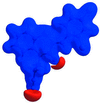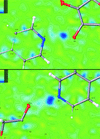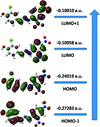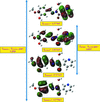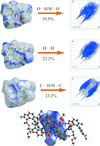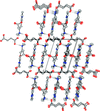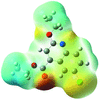issue contents
June 2019 issue

Cover illustration: The crystal structures of six coordination complexes of ZnII and NiII with pyridine-2,6-dicarboxylic acid and its 4-chloro and 4-hydroxy derivatives are described and compared to pinpoint the different coordination behaviour of the two divalent cations. In particular, the present study highlights the role of crystal field stabilization energy in the formation of complexes with metal ions of similar dimensions but different electronic configuration, i.e. the incomplete d8 subshell of NiII and the fully symmetric d10 subshell of ZnII. See: Kremer & Englert [Acta Cryst. (2019). E75, 903-911].
research communications
Download citation


Download citation


The molecular structure of the title compound, C23H34N2O4, has C2 symmetry. In the crystal, interlocked dimers are formed through quadruple N—H⋯O hydrogen bonds between pyrrole N—H groups and carbonyl O atoms.
CCDC reference: 1912079
Download citation


Download citation


The tris(trimethylsilylsiloxide) ligand, also known as hypersiloxide, is an extremely bulky group. In an attempt to make the monomeric Al(OSi(SiMe3)3)3, AlCl3 was combined with 3 equiv. of potassium hypersiloxide. The title compound, a KCl adduct of aluminium tris(hypersilyloxide) that is dimerized through a planar K2Cl2 ring, was isolated.
CCDC reference: 1910627
Download citation


Download citation


The title compound crystallizes with two independent molecules in the asymmetric unit. In the crystal, molecules are linked by N—H⋯O hydrogen bonds, C—H⋯π, I⋯S and I⋯I interactions into a three-dimensional network.
CCDC reference: 1908908
Download citation


Download citation


In the title compound, the dihydrobenzothiazine moiety is folded about the S1⋯N1 axis. In the crystal, inversion dimers, generated by C—HBnz⋯NPrpnit (Bnz = benzene, Prpnit = propanenitrile) hydrogen bonds, are linked into stepped ribbons extending parallel to [110] by C—HPrpnit⋯OThz (Thz = thiazine) hydrogen bonds. The ribbons are joined into pairs by inversion-related C=O⋯Cl interactions.
CCDC reference: 1913051
Download citation


Download citation


In the title 1:2 co-crystal, L-ascorbic acid (LAA) and 4,4′-bipyridine (bpy) co-crystallize with two molecules of LAA, and one molecule of bpy in the asymmetric unit. The structure was modeled in two parts due to possible proton transfer from LAA to the corresponding side of the bpy molecule having an occupancy of approximately 0.25 and part 2 with an occupancy of approximately 0.75.
CCDC reference: 1910963
Download citation


Download citation


Two oxetanocin A derivatives have been synthesized stereospecifically. The crystal structures of both derivatives and a synthetic intermediate are reported on herein.
Download citation


Download citation


The water molecule connects the molecules in the crystal packing. The crystal structure exhibits N—H⋯O, O—H⋯O and O—H⋯N interactions, resulting in the formation of a three-dimensional framework.
CCDC reference: 1912546
Download citation


Download citation


In the crystal structure of the title compound, (C6H16N)2[Sn(C2O4)2Cl2], the cations are linked to the anions by N—H⋯O hydrogen bonds to generate chains along the c-axis direction. Only van der Waals interactions are observed between the chains.
CCDC reference: 1833609
Download citation


Download citation


In the title compound, C—H⋯O hydrogen bonds and weak C—H⋯π interactions link adjacent molecules into a three-dimensional supramolecular network.
CCDC reference: 1913649
Download citation


Download citation


The title compound shows a molecular framework with the diphenylethyne unit slightly deviating from planarity and the L-alanine moieties adopting a distorted helical conformation. The crystal structure features a two-dimensional network supported by N—H⋯O and C—H⋯O hydrogen bonding.
CCDC reference: 1912918
Download citation


Download citation


The title tridentate ligand (HL1), crystallizes with three independent molecules in the asymmetric unit. Its reaction with Cu(Ac)2 produced a tetranuclear complex with a central tetrakis(μ-acetato)dicopper paddle-wheel moiety linked on either side via bridging acetate anions to a mononuclear copper(II)–(L1) complex.
Download citation


Download citation


In the crystal structure of the title compound, the FeIII ions are octahedrally coordinated by four N atoms of a porphyrin moiety as well as two 4-methoxypyridine ligands into discrete complexes that are charge-balanced by perchlorate anions.
CCDC reference: 1913651
Download citation


Download citation


The –COOH group of the title compound adopts a syn conformation (O= C—O—H = 0°) unlike the anti conformation observed in related maleamic acids. This is correlated with the formation of carboxylic acid inversion dimers linked by pairwise O—H⋯O hydrogen bonds in the crystal of the title compound rather than an intramolecular O—H⋯O hydrogen bond.
CCDC reference: 1914411
Download citation


Download citation


The title Schiff base compound was obtained from a condensation reaction of 4-chloro-3-hydroxybenzaldehyde and 2,4-dinitrophenylhydrazine. The molecule is almost planar with the dihedral angle between the benzene rings being 3.70 (17)°.
CCDC reference: 1912273
Download citation


Download citation


The title bischalcone shows s-trans and s-cis conformations for its C=C—C=O bonds.
CCDC reference: 1914420
Download citation


Download citation


The synthesis, structural characterization and Hirshfeld surface analysis of 4-[4-(1H-benzo[d]imidazol-2-yl)phenoxy]phthalonitrile, a substituted phthalonitrile derivative carrying a benzimidazole functional group, are reported.
CCDC reference: 1846754
Download citation


Download citation


In the crystal structure of the title compound, the molecules are linked by pairs of O—H⋯O hydrogen bonds, forming inversion dimers with an  (18) ring motif.
(18) ring motif.
CCDC reference: 1902148
Download citation


Download citation


The crystal structure of the complex CuII-6-carboxylato-2-(pyridylmethyl)-bis(pyridin-2-ylmethyl)amine is reported and compared to similar structures in the literature. The title compound is observed to form extended chains in the solid state, in contrast to the literature examples discussed.
CCDC reference: 1913833
Download citation


Download citation


The title CuII dithiocarbazate complex features a square-planar trans-N2S2 donor set for the metal atom (site symmetry  ). Supramolecular layers parallel to (
). Supramolecular layers parallel to ( 02) are found in the crystal, being sustained by π–π(furyl) and C—H⋯π interactions.
02) are found in the crystal, being sustained by π–π(furyl) and C—H⋯π interactions.
CCDC reference: 1913482
Download citation


Download citation


The self-assembly of Cu2+ cations, chloride anions and 4,4′-bi-1,2,4-triazole) (C4H4N6; btr) in aqueous solution resulted in a new three-dimensional coordination polymer, which was structurally characterized. A characteristic feature of the coordination framework is the presence of [–(μ-Cl)CuCl–]n helical chains interlinked by the btr ligands.
CCDC reference: 1911618
Download citation


Download citation


The title Schiff base compound displays an E configuration with respect to the C=N double bond. The pyridine and benzene rings subtend a dihedral angle of 29.63 (7)°. In the crystal, the molecules are linked by N—H⋯O, C—H⋯O, O—H⋯O and O—H⋯N hydrogen-bonding interactions.
CCDC reference: 1587259
Download citation


Download citation


The crystal structure of the title compound is based on the molecular heterobimetallic unit {Ag2(VO2F2)2(tr)4} supported by the 1,2,4-triazole ligand, 1-(1,2,4-triazol-4-yl)-3-carboxyadamantane.
CCDC reference: 1915603
Download citation


Download citation


In the crystal, the molecules are linked by pairs of O—H⋯O hydrogen bonds, forming dimers with an  (18) ring motif. The dimers are linked by pairs of C—H⋯O contacts with an
(18) ring motif. The dimers are linked by pairs of C—H⋯O contacts with an  (10) ring motif, forming ribbons extended along the [2
(10) ring motif, forming ribbons extended along the [2 0] direction.
0] direction.
CCDC reference: 1915380
Download citation


Download citation


The title molecule is twisted about the methine-C—C(carbonyl) bond [the O—C—C—O torsion angle is −20.8 (7)°] and the dihedral angle between the bromobenzene and phenyl rings is 43.2 (2)°.
CCDC reference: 1915470
Download citation


Download citation


In the bimetallic title compound, [Cd2(C6N3O2H9)2Cl6], both cadmium atoms adopt a distorted CdCl4O trigonal–bipyramidal coordination geometry.
CCDC reference: 1915915
Download citation


Download citation


The crystal structure of new polymorph is reported in which an N—H⋯O hydrogen bond links molecules into chains with antiparallel (centrosymmetric) packing.
CCDC reference: 1916098
Download citation


Download citation


The title compound, C9H11NO2, was synthesized and characterized in the solid state. The molecular Hirshfeld surfaces were obtained to determine the interactions between the molecules and explore the nature of the packing of the molecules in the crystal.
CCDC reference: 1899995
Download citation


Download citation


The title compound is composed of a bis(hydrazoniminato)copper(II) complex and the basic hydrazone imine shows a molecular framework with layers each constructed from one of the two components arranged in alternating order. Layer formation is supported by C—H⋯O interactions.
CCDC reference: 1912679
Download citation


Download citation


The synthesis and structures of a series of 6-aryl-1,3-diphenylfuvlenes with (fulvene is 5-methylidenecyclopenta-1,3-diene) varying methylation patterns on the 6-phenyl substituent are reported. A network of C—H⋯π ring interactions consolidates the packing in each structure.
Download citation


Download citation


Two independent N—H⋯O hydrogen bonds link all of the molecules into a continuous three-dimensional framework structure. The quinazoline ring adopts an envelope conformation with the 2,5-dimethoxyphenylunit occupying a quasi-axial site.
CCDC reference: 1875494
Download citation


Download citation


The solvated centrosymmmtric title compound, [Li2(C24H34O4P)2(C10H8N2)2]·2C7H8, was formed in the reaction between {Li[(2,6-iPr2C6H3-O)2POO](MeOH)3}(MeOH) and 2,2′-bipyridine (bipy) in toluene. The diaryl phosphate ligand demonstrates a μ-κO:κO′-bridging coordination mode and the 2,2′-bipyridine ligand is chelating to the Li+ cation generating a distorted tetrahedral LiN2O2 coordination polyhedron. The complex exhibits a unique dimeric Li2O4P2 core. Catalytic systems based on the title complex and on the closely related complex {Li[(2,6-iPr2C6H3-O)2POO](MeOH)3}(MeOH) display activity in the ring-opening polymerization of ∊-caprolactone and L-dilactide.
CCDC reference: 1915965
Download citation


Download citation


The title compound crystallizes with four unique disaccharide molecules and four water molecules in the asymmetric unit. In the crystal, the disaccharide and water molecules form layers parallel to the bc plane via hydrophilic interactions.
CCDC reference: 1915954
Download citation


Download citation


Intermolecular interactions in both crystal structures are dominated by hydrogen bonding. The common  (8) hydrogen-bonding motif links carboxylic acid groups on adjacent molecules in both structures.
(8) hydrogen-bonding motif links carboxylic acid groups on adjacent molecules in both structures.
Download citation


Download citation


The crystal structure of novel binuclear CoIII complex with a Schiff base ligand formed in situ from cysteamine (2-aminoethanethiol) and 5-bromosalicylaldehyde is reported.
CCDC reference: 1916953
Download citation


Download citation


The title compound crystallizes as a racemic mixture in the monoclinic space group C2/c. In the crystal, the 1,1,3,3-tetracyano-2-ethoxypropenide anions and the water molecules are linked by O—H⋯N hydrogen bonds, forming chains running along the [010] direction. The bpy ligands of the cation are linked to the chain via C—H⋯π(cation) interactions involving the CH3 group.
CCDC reference: 1915961
Download citation


Download citation


The asymmetric unit of the title compound consists of one half-molecule, the whole all-trans molecule being generated by an inversion centre. In the crystal, the molecules interconnected by C—H⋯O and C—H⋯π interactions.
CCDC reference: 1916720
Download citation


Download citation


The title compounds, 4,4′-{[1,3-phenylenebis(methylene)]bis(oxy)}bis(3-methoxybenzaldehyde) (I) and 4,4′-{[(1,4-phenylenebis(methylene)]bis(oxy)}bis(3-methoxybenzaldehyde) (II), each crystallize with half a molecule in the asymmetric unit. The whole molecule of compound (I) is generated by twofold rotation symmetry, while the whole molecule of compound (II) is generated by inversion symmetry.
Download citation


Download citation


There are small differences in the molecular geometries of the title compounds regarding the orientation of methoxyethyl or butyl group. Common features in the two molecular structures are the presence of an intramolecular N—H⋯Ocarbonyl hydrogen bond and the inclination of nitrobenzene ring to the benzofuran mean plane.
Download citation


Download citation


A dispiro compound bearing two cyclohexyl moieties and a central sulfur-rich seven-membered ring was re-synthesized and newly crystallized. The modified synthetic procedure, the compound's purification and characterization and the crystal structure – which is only the second of its kind – including non-classical hydrogen-bonding interactions are reported and discussed.
CCDC reference: 1916548
Download citation


Download citation


In the title pyridazinone derivative, the unsubstituted phenyl ring and the pyridazine ring are inclined to each other, making a dihedral angle of 17.41 (13)°, whereas the Cl-substituted phenyl ring is nearly orthogonal to the pyridazine ring [88.19 (13)°], C21H19ClN2O3, contains one independent molecule. C—H⋯O hydrogen bonds, weak C—H⋯π and weak offset π–π stacking interactions stabilize the packing.
CCDC reference: 1917654
Download citation


Download citation


Δ2-Isoxazolines constitute an important class of five-membered heterocycles which have significant synthetic and biological applications. Herein is presented a concise route to the synthesis of liquid crystals based on isoxazolines and structural characterization of 5-[4-(tert-butoxy)phenyl]-3-[4-(n-octyloxy)phenyl]-4,5-di-hydroisoxazole.
CCDC reference: 1917652
Download citation


Download citation


The title compound has a single protonated psilacetin cation and one half of a fumarate dianion in the asymmetric unit. The ions are held together through N—H⋯O hydrogen bonds in infinite one-dimensional chains along [111].
CCDC reference: 1917404
Download citation


Download citation


Different electron configurations for ZnII (d10) and NiII (d8) lead to less regular coordination environments for the former: ZnII adopts strongly distorted octahedral or even fivefold coordination spheres whereas NiII favours rather regular octahedra. As a consequence, only the more flexible zinc cations may act as nodes in two-dimensional extended structures.
Download citation


Download citation


The title quinoline derivative is essentially planar with the ethyl acetate mean plane making a dihedral angle of 5.02 (3)° with the ethyl 6-chloro-2-ethoxyquinoline mean plane. In the crystal, offset π–π interactions involving inversion-related pyridine rings [centroid-to-centroid distance = 3.4731 (14) Å] link the molecules into columns along the c-axis direction.
CCDC reference: 1890687
Download citation


Download citation


In the crystal structure of the title compound, the FeII ions are ocathedrally coordinated, forming discrete complexes that are linked into chains by intermolecular C—H⋯O interactions.
CCDC reference: 1918968
Download citation


Download citation


In the title salt, C22H46N42+·2NO3−·2H2O, the dication lies about an inversion center. In the crystal, N—H⋯O, O—H⋯O and N—H⋯N hydrogen bonds connect the anions, cations and water molecules, forming a three-dimensional network.
CCDC reference: 1918729
Download citation


Download citation


In the crystal structure of the title compound, the NiII cations in the two unique complexes are coordinated in a square-planar coordination environment by the N atoms of a porphyrin molecule.
CCDC reference: 1918135
Download citation


Download citation


In the crystal structure of the new polymorph of of μ-oxido-bis[(5,10,15,20-tetraphenylporphyrinato)iron(III)], two FeIII tetraphenylporphyrin units are linked by μ2-oxido O atoms into dimers, leading to a square-pyramidal coordination for each of the cations.
CCDC reference: 1918323
Download citation


Download citation


The title compound was synthesized from naphthalene diimide and methylthiopropiamine. The asymmetric unit consists of half of the total molecule as the molecule lies on an inversion center. Intramolecular C—H⋯O and C—H⋯S hydrogen bonds cause the molecule to have an anti conformation. In the crystal, C—H⋯O and C—H⋯S hydrogen bonds and π–π interactions lead to the formation of a two-dimensional network structure parallel to (110). Hirshfeld surface analysis confirmed the intermolecular interactions.
CCDC reference: 1919395


 journal menu
journal menu














